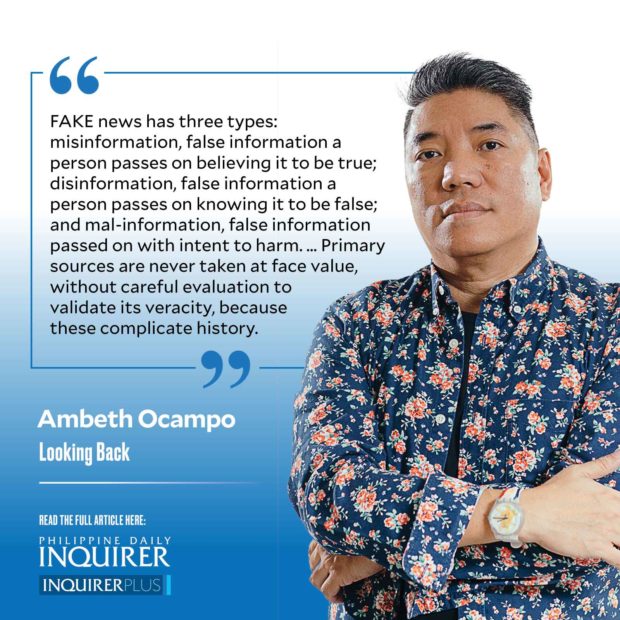History: It’s complicated

Heavy books I do not read, I use as door stoppers. One favorite is a handsome three-volume compilation of primary sources entitled “Vital Documents on Proclamation No. 1081 Declaring a State of Martial Law in the Philippines: From the Declaration of Martial Law (September 21, 1972) to the Ratification of the New Constitution (January 17, 1973).” Here, you will find the text of the Sept. 21, 1972 declaration that provides the historical context as seen by Ferdinand Marcos Sr. at the time. The simple-minded or deluded will take the document at face value, but historians interrogate the primary source to validate its veracity.
While the martial law declaration was “signed” on Sept. 21, 1972, a footnote in the compilation clarifies that:
“This proclamation while prepared and signed on the 21st of September was transmitted to the Defense Authorities through Sec. Juan Ponce Enrile on the 22nd of September for implementation upon my clearance. Such clearance for implementation was given at 9.00 p.m., 22nd September after the ambush of Sec. Juan Ponce Enrile at 8.10 p.m. at Wack Wack Subdivision, Mandaluyong Rizal.”
There is a difference between the date of the document, the date of its implementation, and the date of its proclamation or when the declaration of martial law was made known to the public. Marcos himself made this clear when he addressed the Philippine Historical Association on Nov. 28, 1972:
“If by proclamation is meant, my appearing on television and saying that martial law is enforced, it was on September 23, [1972]. But when did I sign the proclamation on martial law? I actually signed it on September 17. But it was held and it was suspended and I kept it in my possession. I kept it in my possession, because on September 17 I wanted to be sure that the things I want to know were definitely confirmed.”
Therefore, the proclamation was signed on Sept. 17. He had a penchant for the number seven and decided to postdate the document to Sept. 21 that is three times seven. Clearance for implementation was given on the evening of Sept. 22, and it was made public in a televised address on Sept. 23. What may appear as historical hairsplitting should underscore how complicated history can be. I came of age during martial law, believing the dark night began on Sept. 21.
Marcos himself left us with a tangled history. He began by playing the historians:
“This is the first time I reveal this because I believe that the Philippine Historical Association is entitled to the particular fact of history. I signed two copies [Proclamation No. 1081], only two copies of this proclamation.
“One copy was supposed to be signed on September 21, but it is dated September 21, [1972]. I wanted a period within which I could commune with myself and with God and ask him whether it was correct for me to proclaim martial law. I asked for a sign. He gave me several signs. I told myself, if this occurs, I will immediately order martial law to be enforced. And it occurred. It did not only occur; it seems that I was being led and guided by some strange greater mind above me, and I felt it and knew it. And therefore, even before the ambuscade on Secretary Ponce Enrile, I had already ordered the enforcement of the proclamation. There are some who will say that because of the sequence of events, the enforcement of the proclamation must have been due to the ambuscade of Secretary Ponce Enrile. It is not true. That is not true. It is very far from the truth. Long before that, I had decided to proclaim martial law.”
In his 2012 memoirs, Juan Ponce Enrile related that, on the eve of Marcos’ second term, he was instructed to prepare a legal study on martial law. The confidential report was submitted to the president at the end of January 1970. Martial law had been in Marcos’ mind long before he actually put the idea into action.
FAKE news has three types: misinformation, false information a person passes on believing it to be true; disinformation, false information a person passes on knowing it to be false; and mal-information, false information passed on with intent to harm. As a historian, I may add the half-truth meant to confuse and confound. Primary sources are never taken at face value, without careful evaluation to validate their veracity, because these complicate history.
—————-
Comments are welcome at aocampo@ateneo.edu




















